In Costa Rica: Facts


Costa Rican flag
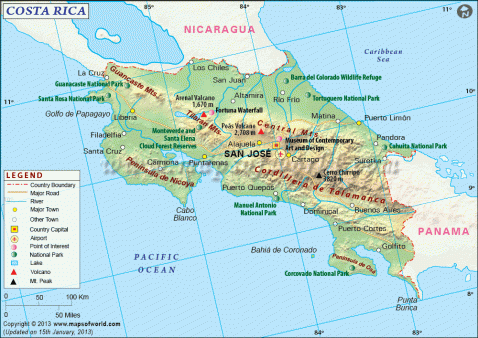
Costa Rica
Costa Rica is a world leader in land conservation – but it hasn’t always been that way. In 1500, over 95% of the area was forested, but by 1987 only 21%. By 2010, 52% was forested and today, a bit more. With 20 national parks, 8 biological reserves, plus animal refuges, and protected areas, 26 percent of Costa Rica’s land is protected.

Along a trail in Costa Rica
One of those important parks is the Arenal Volcano National Park, 29,692-acre (12,016-hectors) that includes both the Arenal Volcano and the dormant Chato Volcano. Beginning near Lake Arenal, the park has hiking trails and observational points. Of the over 200 volcanic formations in Costa Rica about 112 have shown some type of activity: Arenal is the most active volcano in Central America, while Poás is the second widest volcanic crater in the world, and Irazú is Costa Rica’s tallest volcano.

Arenal Volcano – the largest recorded eruption was in 1968
Costa Rica is serious about land conservation; it offers farmers, for instance, yearly subsidies if they keep part of their land forested.
Another popular tourist destination is Manuel Antonio National Park: on Costa Rica’s central Pacific coast; it includes rugged rainforest, white-sand beaches and coral reefs. It contains a vast diversity of tropical plants and wildlife, including three-toed sloths, endangered white-faced capuchin monkeys, and hundreds of bird species. The park’s 1,680 acres (680 hectares) have hiking trails meandering from the coast up into the mountains.

Manuel Antonio National Park – beautiful!
But these are only two of the many wildlife and conservation sites you can visit in Costa Rica. It is one of the most valued environmental destinations in the world – with over 100 protected areas to visit.
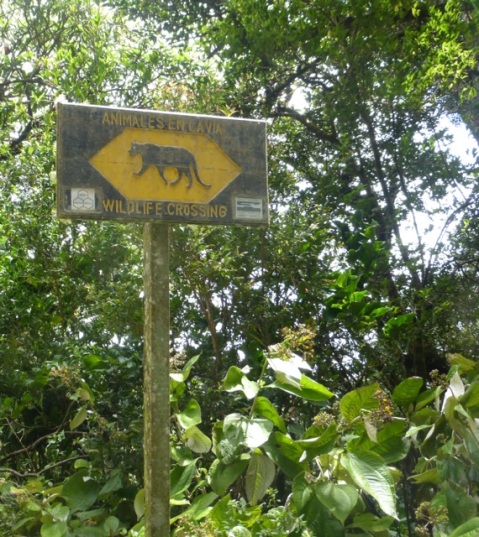
Wildlife Crossing – puma

Costa Rica – a land of conservation and adventure
<http://costa-rica-guide.com/maps/printable-costa-rica-map/>.
There are zip lines, water adventures, beaches, wildlife tours, and much more to see in Costa Rica.
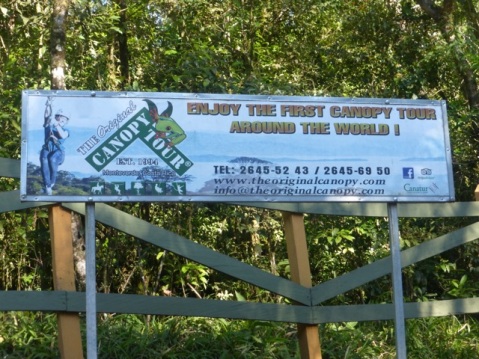
The first – and some of the best zip lines
Other important facts:
- The Costa Rican army was abolished in 1948 after a grim civil war that killed 2,000 people in 44 days.
-

Costa Rican civil war in 1948
- On 24 April, 1944, led by José María (Pepe) Figueres, a powerful coffee grower and outspoken rival of Calderón (the previous president), anti-government forces entered San José, almost six weeks after beginning a revolt in southern Costa Rica against the contested election of the Picado government. The United States helped determine the outcome of the revolution by its mobilization in the Canal Zone, constant pressure on Picado, and cutting off Nicaragua’s (Somoza’s) help. Also, throughout the country, armed groups were formed, trained by Guatemalan military advisors, in part, we were told, because of a promise by Figueres to send Costa Rican fighters later to Guatemala.
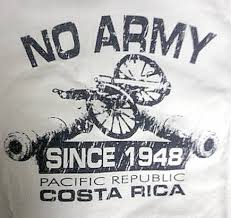 Over the following 18 months, Figueres acted as interim president, during which time he drafted a new constitution that prohibited presidential reelection, dissolved the communist party in Costa Rica, granted women and blacks the right to vote, abolished the army, and established a neutral body that would oversee future elections (the Electoral Tribunal). All of the social reforms that Calderón had established were maintained. Banks and insurance companies were nationalized, and ten percent of all bank funds were seized for reconstruction. In 1949, Figueres turned the country over to Ulate, who had run as the unified opposition party leader, challenging Calderón’s party in the 1948 election. “Don Pepe” Figueres was elected president in 1953 and again in 1970. Upon his death in 1990, he was remembered as one of Costa Rica’s greatest leaders and a crusader against political corruption. He also never kept his promise to send troops to Guatemala; he knew the horror of war and didn’t want any more Costa Ricans to die. Costa Rica still has no standing army.
Over the following 18 months, Figueres acted as interim president, during which time he drafted a new constitution that prohibited presidential reelection, dissolved the communist party in Costa Rica, granted women and blacks the right to vote, abolished the army, and established a neutral body that would oversee future elections (the Electoral Tribunal). All of the social reforms that Calderón had established were maintained. Banks and insurance companies were nationalized, and ten percent of all bank funds were seized for reconstruction. In 1949, Figueres turned the country over to Ulate, who had run as the unified opposition party leader, challenging Calderón’s party in the 1948 election. “Don Pepe” Figueres was elected president in 1953 and again in 1970. Upon his death in 1990, he was remembered as one of Costa Rica’s greatest leaders and a crusader against political corruption. He also never kept his promise to send troops to Guatemala; he knew the horror of war and didn’t want any more Costa Ricans to die. Costa Rica still has no standing army.-

“Don Pepe” Figueres on the right
- Costa Rica has more teachers than police!
- Literacy rate is 95% for men and women.
- Infant mortality /maternal mortality rate is 25 per 100,000 live births and it continues to go down. In contrast, in 1987, there were 7.2 deaths of mothers per 100,000 live births in the United States, according to the Centers for Disease Control and Prevention. In 2011, that number more than doubled, jumping to 17.8 deaths per 100,000 births mainly because of obesity-related complications. While the U.S. rate is still better than Costa Rica’s – that may not be true for long.
- President Luis Guillermo Solís won the 2014 election with over 77% of the vote. This was the largest margin ever recorded for a free election in Costa Rica. He is a member of the center-left Citizens’ Action Party. Now he isn’t as popular as when he was elected because the employment rate hasn’t improved as much as hoped.
-

Costa Rican President Luis Guillermo Solís
Previously, Costa Rica’s president was Laura Chinchilla, Costa Rica’s first female president and sixth female elected for president of a Latin American country.
- In the 1950’s, the Monteverde Quaker community started with nine families from the U.S. – seeking a peaceful country.
-

A Quaker dairy treat – in Monteverde, Costa Rica
- It has one of the highest life expectancies in the world according to the World Bank, Life expectancy at birth is 80 years compared to 79 in the United States. The Nicoya region of Costa Rica is also one of five Blue Zones—“longevity hotspots” populated by the longest-living people in the world—on the globe.
- At 19,730 square miles, Costa Rica measures slightly smaller than Lake Michigan. It has 801 miles (1,290 km) of coastline.
- It is home to more than 500,000 species – with nearly 3 percent of the world’s biodiversity. Corcovado National Park has been deemed “the most biologically intense place on the planet.”
-

A colorful bug on my jeans – in Costa Rica
- Costa Rica contains approximately 90 percent of the butterfly species found in Central America, 66 percent of all neo-tropical butterflies, and about 18 percent of all butterfly species in the world.
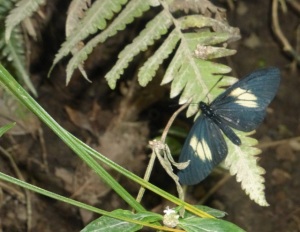
A Sara butterfly
– and over 50 species of hummingbirds.

One of the many kinds of hummingbirds in Costa Rica
- Costa Ricans are some of the happiest people on Earth according to the Happy Planet Index, which uses three criteria—life expectancy, experienced well-being, and Ecological Footprint—to determine the overall happiness levels of 151 countries across the globe. With a score of 64.0, Costa Rica is near the top of this list while the United States has a happiness index of 37.3.
- In case you think that Costa Rica is perfect, know that pedestrians are called “targets” and speed bumps are “son muertos” – [they are] dead people. Do pay attention when you cross a street.
- Pura Vida is the response of locals when asked how they are or in passing to say “hello or goodbye.” Pura vida is a state of mind. Costa Ricans take every opportunity to live life to the fullest.
Visit – you will love the people, the conservation lands, the adventure tours. . .
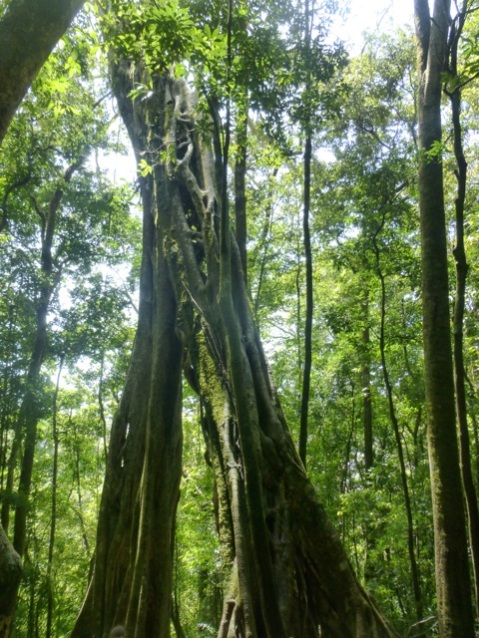
A magnificent – and fun (for people) – Strangler Fig

That’s me on the way up. The view from the top was spectacular. I felt like a bird perching high above the land.
Go to Costa Rica. You’ll love it.
Pura vida, Renée
Costa Rica… A good, almost perfect, example of what civility is! I dream with visiting it. Both due to its amazing beaches and warm, affectionate people. And I cried while reading the post – it wasn’t a cry of sadness, but yes of happiness – thank yuh for such a hopeful post! The fact of Costa Rica having no army should give us a hope that the world can (and will!) better, in both civil and politics aspects 🙂 Costa Rica teach us that education is the better and only truly efficient gun if we want to eliminate serious flaws who affect the world nowadays, such as political crisis and a rampant on criminality rates. Brazil isn’t a paradise anymore, but we still hopeful it’ll better. Sometimes, I think about moving me to Bahamas or St. Vicent & Grenadines, when I become adult, just after ending university, but… I’ll only do it if Brazil has no chance of better. Perhaps I spend a season on the Caribbean, Asian southwest & South Pacific islands, more for pleasure than other thing 😉 but I’ll never abandon my country. I’m not the best example of a patriot girl, but I love my country. And I hope it’ll better on future. I really hope. I have fear of being assaulted or a break into our house, even though we live into an apartment 😦 but yuh’re true when yuh said Brazil is too nice for me abandon it, specially on a crisis moment like this, when we’re the last chance of our country. So, I decide, I’ll not abandon my country. Never. Only if it do a horrible thing, such as a civil war (who’s pretty improbable, considering most Brazilian belongers are pacific, just like me) 😉 so, I’m still with some hope my country can better, as yuh can see. And I know that USA isn’t a perfect country. To say true, none country is perfect. All of them have flaws, so, if we can’t change the whole world, we can do our part, by trying it and doing good acts. I, for example, feel an intense need to help stray dogs and/or mistreated ones. I usually feed them, when I see starving mutts on streets. I know it’s a small act, but it’s a kind small act who help them, because I can’t adopt dogs anymore. At least for an awhile, until I enter at university. After it, I’ll, I decide, to adopt a mutt 😉 I’ll not be changing the world by doing this, but I’ll change this hopeless animal’s world 🙂 I feel so sad by those emaciated African children, who dies not just of starvation, but yes of malaria, who’s an almost forgotten disease for us, but endemic on African continent, without counting ebola and even diseases whore considered banal by us, such as measles, but I can’t do much for them, except donating some quantity to DWB (Doctor Without Borders), and let they do their work. But I really hope with the dream those children wouldn’t suffer anymore. I know it’s an utopia, but it’s better to be a dreamer instead of conforming myself with an imperfect reality. I really hope this world would be perfect, basically an Earthly Paradise, independently of anyone’s belief. So how’s your idea of what a perfect world should be?
Hi Rosita: I think the world is in good hands with young people like you. There is much for all of us to do. We are all needed, and we need to see what we can do where we are – and do it the best we can – and love one another especially the ones who may not be so easy to love.
As poet Elizabeth Alexander says, . . .
What if the mightiest word is love?
Love beyond marital, filial, national,
love that casts a widening pool of light,
love with no need to pre-empt grievance.
In today’s sharp sparkle, this winter air,
any thing can be made, any sentence begun.
On the brink, on the brim, on the cusp,
praise song for walking forward in that light.
From<ryfoundation.org/poem/182812
Aloha, Renee
Such a beautiful poem! Thanks, dear! I just don’t think about being a DWB volunteer, because I don’t have emotional capacity of seeing certain situations, such as children dying of starvation, and lots of other very sad situations 😦 but I admire them a lot by their beautiful work 😉
Hi Rosita: I just read today that DWB are opening a refugee camp for fleeing Syrians. They will be out of the mud, have a health clinic, and much better housing. Doctors Without Borders does amazing work, I agree. Aloha, Renée
I read on Wikipedia about Nicoya peninsula and it seems to be a pretty adorable place to live😍 I pretend to spend a season of six months/a year on the Caribbean, in the future, some time after I end university, both because I crave island hopping adventure and because I want to expand my horizons even more than I usually travel, and I pretend to visit Costa Rica. It’s on my bucket list. I want to spend a time in Costa Rica and also another time in St Vincent & Grenadines and on the Bahamas. What should I do if I pretend to do this and live not just as a tourist, but to experience the Caribbean way of life for an awhile and volunteer with homeless dogs on those islands? How can I conciliate island hopping and working as a doctor and raising a family with not being the awkward tourist type, but yes an almost belonger?
Hi Rosita: One reason that we travel slowly – staying in a place for weeks (and sometimes months) is to get to know people and the culture (and the local dogs). Getting to work in a new place is also a wonderful way to see more than the tourists who breeze through for a day or two. I recommend slow travel. Aloha, Renée
Thanks, Renee! You have such a special place on my heart. ❤️ I’ll do this recommendation of slow traveling, and I confess I never thought of that before 😉 bcuz my family travel rapidly and we see almost nothing of such a place 😦 I remember when we visited Key West last year, and it was pouring with heavy storm, so we didn’t saw the too famous Caribbean Sea 😦 and when we saw it, we were leaving the island. So, we’re going to the Bahamas in July and I hope we can experience true Caribbean way of living for an awhile. Sadly, we’re going to spend just 3 days on Bahamas 😦 just for curiosity, you said me that you went to the Bahamas 40 yrs ago, no?! Yah, how were the Bahamas on that moment? And did you know just Nassau? Or more another place?! Did you knew Freeport? If yes, how it was? I know this information is a bit (OK, so much!) outdated, but it’s just for compare notes 🙂 so, how it was?!